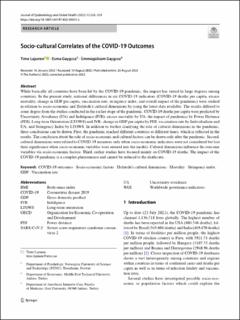| dc.contributor.author | Lajunen, Timo Juhani | |
| dc.contributor.author | Gaygısız, Esma | |
| dc.contributor.author | Gaygısız, Ümmügülsüm | |
| dc.date.accessioned | 2023-01-19T09:53:50Z | |
| dc.date.available | 2023-01-19T09:53:50Z | |
| dc.date.created | 2022-11-08T08:48:17Z | |
| dc.date.issued | 2022 | |
| dc.identifier.citation | Journal of Epidemiology and Global Health (JEGH). 2022, 12 (3), 328-339. | en_US |
| dc.identifier.issn | 2210-6006 | |
| dc.identifier.uri | https://hdl.handle.net/11250/3044529 | |
| dc.description.abstract | While basically all countries have been hit by the COVID-19 pandemic, the impact has varied in large degrees among countries. In the present study, national differences in six COVID-19 indicators (COVID-19 deaths per capita, excess mortality, change in GDP per capita, vaccination rate, stringency index, and overall impact of the pandemic) were studied in relation to socio-economic and Hofstede's cultural dimensions by using the latest data available. The results differed to some degree from the studies conducted in the earlier stage of the pandemic. COVID-19 deaths per capita were predicted by Uncertainty Avoidance (UA) and Indulgence (IVR); excess mortality by UA; the impact of pandemics by Power Distance (PDI), Long-term Orientation (LTOWS) and IVR; change in GDP per capita by PDI; vaccination rate by Individualism and UA; and Stringency Index by LTOWS. In addition to further clarifying the role of cultural dimensions in the pandemic, three conclusions can be drawn. First, the pandemic reached different countries at different times, which is reflected in the results. The conclusion about the role of socio-economic and cultural factors can be drawn only after the pandemic. Second, cultural dimensions were related to COVID-19 measures only when socio-economic indicators were not considered but lost their significance when socio-economic variables were entered into the models. Cultural dimensions influence the outcome variables via socio-economic factors. Third, earlier studies have focused mainly on COVID-19 deaths. The impact of the COVID-19 pandemic is a complex phenomenon and cannot be reduced to the death rate. | en_US |
| dc.language.iso | eng | en_US |
| dc.publisher | Springer Nature | en_US |
| dc.rights | Navngivelse 4.0 Internasjonal | * |
| dc.rights.uri | http://creativecommons.org/licenses/by/4.0/deed.no | * |
| dc.title | Socio-cultural Correlates of the COVID-19 Outcomes | en_US |
| dc.title.alternative | Socio-cultural Correlates of the COVID-19 Outcomes | en_US |
| dc.type | Peer reviewed | en_US |
| dc.type | Journal article | en_US |
| dc.description.version | publishedVersion | en_US |
| dc.source.pagenumber | 328-339 | en_US |
| dc.source.volume | 12 | en_US |
| dc.source.journal | Journal of Epidemiology and Global Health (JEGH) | en_US |
| dc.source.issue | 3 | en_US |
| dc.identifier.doi | 10.1007/s44197-022-00055-3 | |
| dc.identifier.cristin | 2070312 | |
| cristin.ispublished | true | |
| cristin.fulltext | original | |
| cristin.qualitycode | 1 | |

